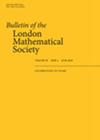Associahedra as moment polytopes
IF 0.8
3区 数学
Q2 MATHEMATICS
引用次数: 0
Abstract
Generalized associahedra are a well-studied family of polytopes associated with a finite-type cluster algebra and a choice of starting cluster. We show that the generalized associahedra constructed by Padrol, Palu, Pilaud, and Plamondon, building on ideas from Arkani-Hamed, Bai, He, and Yan, can be naturally viewed as moment polytopes for an open patch of the quotient of the cluster -variety with universal coefficients by its maximal natural torus action. We prove our result by showing that the construction of Padrol, Palu, Pilaud, and Plamondon can be understood on the basis of the way that moment polytopes behave under symplectic reduction.
求助全文
约1分钟内获得全文
求助全文
来源期刊
CiteScore
1.90
自引率
0.00%
发文量
198
审稿时长
4-8 weeks
期刊介绍:
Published by Oxford University Press prior to January 2017: http://blms.oxfordjournals.org/

 求助内容:
求助内容: 应助结果提醒方式:
应助结果提醒方式:


